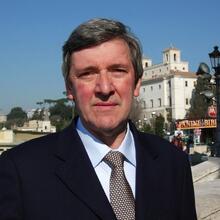Pope Francis continues to be in stable condition and has registered improvements in both breathing and speech, the Vatican said on March 28, the sixth day of the “at least two-month” period of “rest and convalescence” prescribed by his doctors when they discharged him from Rome’s Gemelli Hospital last Sunday.
The 88-year-old pope receives 24/7 health care in Santa Marta, the Vatican guesthouse where he has lived since his election as pope in 2013. The apartment is on the second floor of the hotel-like building and is protected by Swiss Guards around the clock.
The director of the Vatican press office, Matteo Bruni, briefed journalists on the pope's health at noon on Friday, March 28. He said the pope continues with the triple therapies prescribed by his doctors—pharmacological, respiratory and physical therapy—and is registering “improvements” with the respiratory and physical therapies as well as in his speech. Last Sunday, Francis had difficulty speaking and only managed to say a few sentences when he addressed cheering crowds from the hospital window.
From the medical perspective, the pope’s situation is “stable” and the blood analyses taken on Wednesday are “within the norm,” Mr. Bruni reported. The pope has reduced his use of high-flow oxygen, though he still receives it at night, and by day, too, when needed, through nasal tubes.
Since his return to Santa Marta, he has not received visitors, but he continues to work as he did in the hospital. He receives documents from the various dicasteries of the Roman Curia that require his attention.
Pope Francis concelebrates Mass every day in the small private chapel on the second floor, and he follows via streaming the weekly Lenten reflections given by Roberto Passolini, O.F.M.Cap., the preacher of the papal household.
Yesterday, the Vatican published the program of liturgical events during Holy Week and Easter but gave no indication of who would preside at these events. “It’s premature” to decide this now, Mr. Bruni said. “We’ll have to see how the pope’s convalescence evolves.”
Mr. Bruni said the pope was informed about the massive earthquake in Myanmar, a country he visited in 2017, and “is praying” for the people there.
He announced that the next Vatican briefing on the pope’s health will be given on Tuesday, April 1.
Since Pope Francis’ return to Santa Marta on Sunday afternoon, the entire second floor has been isolated, on the instruction of Msgr. Battista Ricca, the director of Santa Marta. He issued a decree that no guest may access the second floor of the guesthouse at any time during the pope’s convalescence.
Two nurses monitor the pope around the clock. The first is Massimiliano Strappetti, the nurse whom Francis credits with saving his life in July 2021 and who also played a crucial role when the life-threatening respiratory crisis struck on Feb. 22. The other is Andrea Rinaldi.
[Related: Who is the nurse who made medical decisions for Pope Francis?]
Dr. Luigi Carbone, the vice director of the Vatican Health Service, who was part of the medical team at Gemelli Hospital, is also the pope’s personal physician during this period of convalescence. He can call on the Vatican’s 24-hour emergency service, should the need arise.
Besides the nurses, the pope is also assisted during the day by his Argentinian and Italian private priest secretaries. They bring him his private correspondence, as well as dossiers from the Roman Curia. They take back decrees, nominations or other documents signed and approved by the pope, who continues to govern the church from his apartment.
Today, for example, the Vatican announced that Pope Francis has appointed the Italian archbishop and theologian Giovanni Cesare Pagazzi, 59, as the archivist and librarian of the Holy Roman Church. At the time of his appointment, Archbishop Pagazzi was the secretary of the Dicastery for Culture and Education. He succeeds the Italian archbishop, Angelo Vincenzo Zani, who turned 75, the age of retirement, four days ago.







